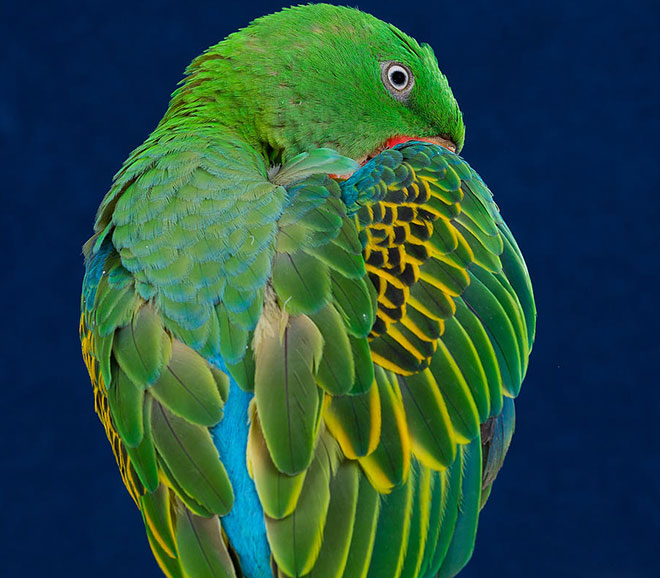 In the wild Great-bills are from many islands of Indonesia – northern, central and southern Moluccas, Tanimbar Islands, Timor, Flores and Sumba in Lesser Sunda Islands, Talaud and Sangir Islands, islands around Sulawasi, western Papaun islands and those off the coast of Vogelkop, Irian and Jaya. Great-billed parrots are the largest member of the Tanygnathus family at approximately 16 inches and weighing about 375-450 grams.
In the wild Great-bills are from many islands of Indonesia – northern, central and southern Moluccas, Tanimbar Islands, Timor, Flores and Sumba in Lesser Sunda Islands, Talaud and Sangir Islands, islands around Sulawasi, western Papaun islands and those off the coast of Vogelkop, Irian and Jaya. Great-billed parrots are the largest member of the Tanygnathus family at approximately 16 inches and weighing about 375-450 grams.
They have an iridescent green with yellow and black scalloping on the wing, a bright blue rump, and a spectacular orange/red beak with a medium tail. They have a fairly long life span of 50 years plus.
Some have thought the Great-billed parrot were cousins to the Eclectus but with few similarities.
They are not dimorphic like the Eclectus but often times the size difference between the males and female are very apparent because the males can be noticeably larger.
Family Rating: Obviously the great-billed parrot has an enormous beak (hence the name); however, they do not use their beaks for biting — they are known to be gentle parrots. Great-bills are very gentle birds that rarely bite, preferring to run away, or push away the offending object so they are ok for families with older kids.
They do require a lot of things to chew on to groom their own beaks because they tend to over grow. They do not tend to be as happy around loud, boisterous birds like macaws and amazons or screaming children, but get along really well with calmer species like Eclectus and African greys.
Great-bills are wonderful companions with calm, gentle, sweet spirits. They love to hang out and see what is going on and bring much enjoyment into a peaceful household.
Talkability/Noise Level: These beautiful birds are known to be crepuscular that means they can be active or alert at night. They, however will be a very loud alarm if someone is creeping around in the house at night, quite like an alarm system if you will. Great-bills are excellent talkers and often begin to talk early.
They also like to show off their vocabulary and tend to talk in front of people. They are usually pretty quiet birds, though when they get excited they can be very loud.
Cuddle Rating: They are more reserved by nature and a more dignified parrot but they happily accept a kiss from their owners on their beak, or to gently stroke their feathers in the direction they grow but don’t count on them to lay on their backs or roll around during play time.
They tend to want to be where their owners are, and enjoy time out with the family but consider them a low maintenance parrot that don’t require face time or shoulder time, a toy will do.
Like Eclectus, Great-bills are female- dominant, so the females tend to be a bit bossier than the males and love to rule the roost. The babies however tend to be clumsy and fall so careful perch positioning is important.
Hypoallergenic: The Great-billed is much like the Eclectus in this way that they are a powder-free parrot. Though any parrot in molting season will shed their pins once new feathers produce can irritate sinuses if a person is sensitive.
Diet: They are known to be “great –eaters” their digestive systems are much like the Eclectus and have very efficient digestive systems so they are good at absorbing all of the nutrition from their food. Pelleted diets can be too rich for them and they have problems with over nutrition.
They do well on a diet of fresh vegetables, a little fruit, cooked or sprouted grains and beans, and seem to like a bit of animal protein as well (cooked chicken, steak or pork), as well as seed mix and nuts for a good vitamin E source.




